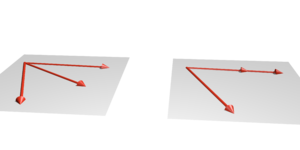Linear Independence of Vectors
Revision as of 14:39, 17 November 2021 by Lila (talk | contribs) (Created page with "thumb|right|Linearly independent vectors in <math>\R^3</math> File:Vec-dep.png|thumb|right|Linearly dependent vectors in a plane in <math>\R^3.</math>...")
A set of vectors is said to be linearly dependent if there is a nontrivial linear combination of the vectors that equals the zero vector. If no such linear combination exists, then the vectors are said to be linearly independent. These concepts are central to the definition of dimension.
- An indexed family of vectors is a linearly independent family if none of them can be written as a linear combination of finitely many other vectors in the family. A family of vectors which is not linearly independent is called linearly dependent.
- A set of vectors is a linearly independent set if the set (regarded as a family indexed by itself) is a linearly independent family.
These two notions are not equivalent: the difference being that in a family we allow repeated elements, while in a set we do not. For example if is a vector space, then the family such that and is a linearly dependent family, but the singleton set of the images of that family is which is a linearly independent set.
Both notions are important and used in common, and sometimes even confused in the literature. -->








